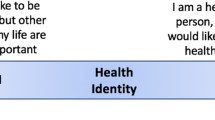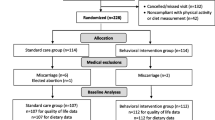Abstract
Objectives Little is known about the antecedents to dietary and physical activity behaviours that can support healthy gestational weight gain (GWG) across different weight status groups in pregnancy. The aim of this study was to use constructs common to dominant health behaviour theories to determine if predisposing, reinforcing and enabling factors for healthy eating, physical activity and weight gain differed between healthy and overweight pregnant women. Methods Pregnant women (n = 664) aged 29 ± 5 (mean ± SD) years were recruited at 16 ± 2 weeks gestation. Measures were self-reported pre-pregnancy weight, psychosocial constructs for healthy eating, physical activity and GWG and demographic data. Height was measured at 16 weeks. Psychosocial constructs were compared between women with pre-pregnancy weight status of healthy (BMI < 25 kg/m2) and overweight (BMI ≥ 25 kg/m2). Results Health behaviour intentions, positive outcome expectations and social support for healthy eating and physical activity were not different between healthy (66 %) and overweight (34 %) women. Overweight women had lower self-efficacy for healthy eating, physical activity and GWG (p < 0.001), higher negative outcome expectations for GWG (p = 0.004), and higher barriers to healthy eating (p = 0.002), and physical activity (p = 0.006). Conclusions for practice Both healthy and overweight women appear motivated to follow a healthy diet, exercise and avoid excess gestational weight during pregnancy. However many psychosocial factors associated with achieving these goals were different between healthy and overweight women. Health behaviour interventions tailored to overweight pregnant women should consider improving self-efficacy, providing support to overcome perceived barriers, validate positive changes made, and assist in managing negative expectations.
Similar content being viewed by others
References
Anderson, A., & Shepherd, R. (1989). Beliefs and attitudes toward “healthier eating” among women attending maternity hospital. Journal of Nutrition Education, 21, 208–213.
Băban, A., & Crăciun, C. (2007). Changing health-risk behaviors: A review of theory and evidence-based interventions in health psychology. Journal of Cognitive and Behavioral Psychotherapies, 7, 45–66.
Bandura, A. (2004). Health promotion by social cognitive means. Health Education and Behavior, 31, 143–164.
Byrd-Bredbenner, C., Abbot, J. M., & Cussler, E. (2011). Relationship of social cognitive theory concepts to mothers’ dietary intake and BMI. Maternal and Child Nutrition, 7(3), 241–252.
Catalano, P. M., & Ehrenberg, H. M. (2006). The short- and long-term implications of maternal obesity on the mother and her offspring. BJOG: An International Journal of Obstetrics and Gynaecology, 113, 1126–1133.
Chang, M.-W., Brown, R., & Nitzke, S. (2008a). Scale development: Factors affecting diet, exercise, and stress management (FADESM). BMC Public Health, 8, 76.
Chang, M.-W., Nitzke, S., Guilford, E., Adair, C. H., & Hazard, D. L. (2008b). Motivators and barriers to healthful eating and physical activity among low-income overweight and obese mothers. Journal of the American Dietetic Association, 108, 1023–1028.
de Jersey, S. J., Nicholson, J. M., Callaway, L. K., & Daniels, L. A. (2012). A prospective study of pregnancy weight gain in Australian women. Australian and New Zealand Journal of Obstetrics and Gynaecology, 52, 545–551.
Evenson, K. R., Moos, M. K., Carrier, K., & Siega-Riz, A. M. (2009). Perceived barriers to physical activity among pregnant women. Maternal and Child Health Journal, 13, 364–375.
Fowles, E. R., & Feucht, J. (2004). Testing the barriers to healthy eating scale. Western Journal of Nursing Research, 26, 429–443.
Gardner, B., Wardle, J., Poston, L., & Croker, H. (2011). Changing diet and physical activity to reduce gestational weight gain: A meta-analysis. Obesity Reviews, 12, e602–e620.
Glanz, K., Kristal, A. R., Sorensen, G., Palombo, R., Heimendinger, J., & Probart, C. (1993). Development and validation of measures of psychosocial factors influencing fat- and fiber-related dietary behavior. Preventive Medicine, 22, 373–387.
Green, L. W., & Kreuter, M. W. (2005). Health program planning: An educational and ecological approach (4th ed.). New York: McGraw Hill.
Institute of Medicine, National Research Council. (2009). Weight Gain During Pregnancy: Reexamining the Guidelines. Washington, DC: National Academies Press.
Kendall, A., Olson, C. M., & Frongillo, E. A, Jr. (2001). Evaluation of psychosocial measures for understanding weight-related behaviors in pregnant women. Annals of Behavioral Medicine, 23, 50–58.
Kremers, S. P. J. (2010). Theory and practice in the study of influences on energy balance-related behaviors. Patient Education and Counseling, 79, 291–298.
Laraia, B. A., Bodnar, L. M., & Siega-Riz, A. M. (2007). Pregravid body mass index is negatively associated with diet quality during pregnancy. Public Health Nutrition, 10, 920–926.
Ling, A. M. C., & Horwath, C. (1999). Self-efficacy and consumption of fruit and vegetables: Validation of a summated scale. American Journal of Health Promotion, 13, 290–298.
Marcus, B. H., & Owen, N. (1992). Motivational readiness, self-efficacy and decision-making for exercise. Journal of Applied Social Psychology, 22, 3–16.
Oken, E., Taveras, E. M., Kleinman, K. P., Rich-Edwards, J. W., & Gillman, M. W. (2007). Gestational weight gain and child adiposity at age 3 years. American Journal of Obstetrics and Gynecology, 196, 322.e1-8.
Oteng-Ntim, E., Varma, R., Croker, H., Poston, L., & Doyle, P. (2012). Lifestyle interventions for overweight and obese pregnant women to improve pregnancy outcome: Systematic review and meta-analysis. BMC Medicine, 10, 47.
Palmer, J. L., Jennings, G. E., & Massey, L. (1985). Development of an assessment form: Attitude toward weight gain during pregnancy. Journal of the American Dietetic Association, 85, 946–949.
Richman, R., Loughnan, G., Droulers, A., Steinbeck, K., & Caterson, I. (2001). Self-efficacy in relation to eating behaviour among obese and non-obese women. International Journal of Obesity and Related Metabolic Disorders, 25, 907–913.
Rowlands, I., Graves, N., de Jersey, S., McIntyre, H. D., & Callaway, L. (2010). Obesity in pregnancy: Outcomes and economics. Seminars in Fetal and Neonatal Medicine, 15, 94–99.
Sallis, J. F., Grossman, R. M., Pinski, R. B., Patterson, T. L., & Nader, P. R. (1987). The development of scales to measure social support for diet and exercise behaviors. Preventive Medicine, 16, 825–836.
Sallis, J. F., Pinski, R. B., Grossman, R. M., Patterson, T. L., & Nader, P. R. (1988). The development of self-efficacy scales for health related diet and exercise behaviors. Health Education Research, 3, 283–292.
Saltzer, E. B. (1982). The weight locus of control (WLOC) scale: A specific measure for obesity research. Journal of Personality Assessment, 46, 620.
Schwarzer, R. (2008). Modeling health behavior change: How to predict and modify the adoption and maintenance of health behaviors. Applied Psychology, 57, 1–29.
Schwarzer, R. (2009). The health action process approach. www.hapa-model.de. Accessed 10 Dec 2009.
Schwarzer, R., Sniehotta, F. F., Lippke, S., Luszczynska, A., Scholz, U., Schüz, B., Wegner, M., & Ziegelmann, J. P. (2003). On the assessment and analysis of variables in the health action process approach: Conducting an investigation. http://web.fu-berlin.de/gesund/hapa_web.pdf. Accessed 10 Nov 2009.
Statistical Services Branch Queensland Health. (2012). Queensland Perinatal Statistics, September 2010–February 2011. Queensland Health.
Stotland, N. E., Haas, J. S., Brawarsky, P., Jackson, R. A., Fuentes-Afflick, E., & Escobar, G. J. (2005). Body mass index, provider advice, and target gestational weight gain. Obstetrics and Gynecology, 105, 633–638.
Streiner, D. L. (2003). Being inconsistent about consistency: When coefficient alpha does and doesn’t matter. Journal of Personality Assessment, 80, 217–222.
Thangaratinam, S., Rogozińska, E., Jolly, K., Glinkowski, S., Roseboom, T., Tomlinson, J. W., et al. (2012). Effects of interventions in pregnancy on maternal weight and obstetric outcomes: Meta-analysis of randomised evidence. BMJ: British Medical Journal, 344, e2088.
Tiedje, L. B., Kingry, M. J., & Stommel, M. (1992). Patient attitudes concerning health behaviors during pregnancy: Initial development of a questionnaire. Health Education and Behavior, 19, 481–493.
Acknowledgments
The authors wish to acknowledge New Beginnings Research staff and students for assistance with data collection, RBWH maternity outpatients’ staff for recruitment support, and the women who participated. Project funding was provided by the Royal Brisbane and Women’s Hospital (RBWH) Foundation for the New Beginnings Healthy Mothers and Babies Study; RBWH Research Advisory Committee and National Health and Medical Research Council (NHMRC) provided PhD Scholarship funding (SdeJ 1017169); JN is funded by the Roberta Holmes Chair through the Australian Communities Foundation (Coronella sub-fund).
Authors’ Contribution
SdeJ conceived and designed the study with support from LD, LC and JN. SdeJ collected the data and performed the analysis. KM provided guidance on statistical analysis. All authors contributed to the interpretation of results, drafting of the manuscript, and approved the final manuscript for submission.
Author information
Authors and Affiliations
Corresponding author
Ethics declarations
Conflict of interest
The authors declare that they have no conflict of interest.
Electronic Supplementary Material
Below is the link to the electronic supplementary material.
Rights and permissions
About this article
Cite this article
de Jersey, S.J., Mallan, K., Callaway, L. et al. A Cross Sectional Comparison of Predisposing, Reinforcing and Enabling Factors for Lifestyle Health Behaviours and Weight Gain in Healthy and Overweight Pregnant Women. Matern Child Health J 21, 626–635 (2017). https://doi.org/10.1007/s10995-016-2148-0
Published:
Issue Date:
DOI: https://doi.org/10.1007/s10995-016-2148-0




